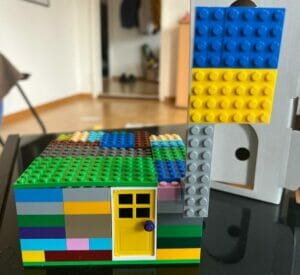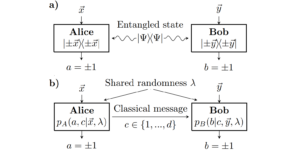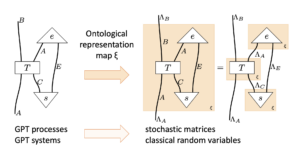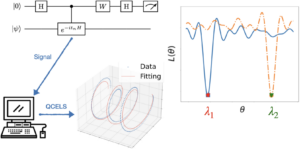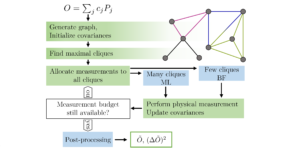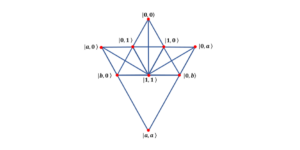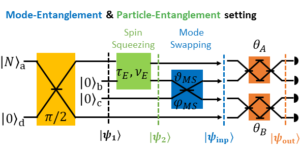1ICFO-Institut de Ciencies Fotoniques, The Barcelona Institute of Science and Technology, 08860 Castelldefels, Spain
2CFIS-Centre de Formació Interdisciplinària Superior, UPC-Universitat Politècnica de Catalunya, 08028 Barcelona, Spain
3Univ Grenoble Alpes, CNRS, Grenoble INP, Institut Néel, 38000 Grenoble, France
4ICREA-Institucio Catalana de Recerca i Estudis Avançats, Lluis Companys 23, 08010 Barcelona, Spain
Find this paper interesting or want to discuss? Scite or leave a comment on SciRate.
Abstract
Mutually unbiased bases correspond to highly useful pairs of measurements in quantum information theory. In the smallest composite dimension, six, it is known that between three and seven mutually unbiased bases exist, with a decades-old conjecture, known as Zauner’s conjecture, stating that there exist at most three. Here we tackle Zauner’s conjecture numerically through the construction of Bell inequalities for every pair of integers $n,d ge 2$ that can be maximally violated in dimension $d$ if and only if $n$ MUBs exist in that dimension. Hence we turn Zauner’s conjecture into an optimisation problem, which we address by means of three numerical methods: see-saw optimisation, non-linear semidefinite programming and Monte Carlo techniques. All three methods correctly identify the known cases in low dimensions and all suggest that there do not exist four mutually unbiased bases in dimension six, with all finding the same bases that numerically optimise the corresponding Bell inequality. Moreover, these numerical optimisers appear to coincide with the “four most distant bases” in dimension six, found through numerically optimising a distance measure in [P. Raynal, X. Lü, B.-G. Englert, {Phys. Rev. A}, { 83} 062303 (2011)]. Finally, the Monte Carlo results suggest that at most three MUBs exist in dimension ten.
Featured image: The relative difference between the value of our Bell inequalities assuming that n MUBs exist in dimension d and the value found by our numerical methods. Zero values mean that the methods found n MUBs in dimension d, while non-zero values mean that the methods did not find n MUBs in dimension d. All the known cases (dimensions two to five and dimension six with two and three MUBs) are correctly identified by the numerics. In dimension six, none of the methods find four MUBs, and all the methods converge to the same set of four bases.
Popular summary
Despite their broad use, there still remain open questions regarding the structure of MUBs. Most prominently, the maximal number of measurements that are pairwise unbiased (“the number of MUBs”) is unknown if the dimension of the quantum system is a composite number. In particular, in dimension six we only know that the number of MUBs is between three and seven. A long standing open conjecture is that of Zauner’s, stating that there exist no more than three MUBs in dimension six. This decades-long conjecture is backed by some numerical evidence, but there exists no proof to this day.
In this work we tackle Zauner’s conjecture through Bell non-locality. Bell non-locality concerns two experimenters who are not allowed to communicate, but can share some correlations in the form of classical randomness or a shared quantum state. It has been shown that sharing quantum resources can lead to experimental data that cannot be explained by classical physics (more precisely, by so-called local hidden variable models). This is known as Bell’s theorem, and it has been experimentally verified in the last decade. Witnessing the non-classicality of experimental data is most commonly done via so-called Bell inequalities, which are functions of the measurement outcome probabilities occurring in the experiment. Classical data must satisfy Bell inequalities, while quantum data may violate them.
Recently, Bell inequalities have been found that are maximally violated if one of the parties employs a pair of MUB measurements of a given dimension. In this work, we extend these inequalities to new ones, maximally violated by a selected number of MUB measurements in a given dimension. Moreover, if the dimension in the experiment is fixed, the maximal violation is obtained if and only if the employed measurements correspond to the selected number of MUBs in the given dimension. Therefore, deciding whether a selected number of MUBs exist in a given dimension is equivalent to finding the maximal violation of the corresponding Bell inequality in this fixed dimension.
While finding this maximal violation is in general a hard problem, we employ three different numerical methods as an attempt to find the maximal violation of our Bell inequalities in a fixed dimension. Two of these methods are variants of semidefinite programming techniques, while the third one is inspired by statistical physics and is called simulated annealing. While all of these methods are heuristic—that is, there is no guarantee that they will find the true optimum of the problem—one can gauge their performance by applying them to optimisation problems whose optimum is known. In particular, we find that all of the three methods are correctly able to identify MUB measurements in the cases where they are known to exist. Furthermore, in the cases where they are known not to exist, all three methods converge to the same set of measurements up to numerical precision. We then apply our methods to the first unknown case, that is, four MUBs in dimension six. None of the methods are able to identify four MUBs in dimension six, but again they all converge to the same set of four measurements up to numerical precision. Furthermore, the simulated annealing technique does not find four MUBs in the next composite dimension, dimension ten. Therefore, while rigorous claims cannot be made due to the heuristic nature of our techniques, our results support Zauner’s conjecture from the new perspective of Bell non-locality.
► BibTeX data
► References
[1] I D Ivanovic. Geometrical description of quantal state determination. Journal of Physics A: Mathematical and General, 14(12):3241–3245, 1981. doi:10.1088/0305-4470/14/12/019.
https://doi.org/10.1088/0305-4470/14/12/019
[2] G. Brassard C. H. Bennett. Quantum cryptography: Public key distribution and coin tossing. Proceedings of IEEE International Conference on Computers, Systems and Signal Processing (IEEE, 1984), 175:8, 1984. doi:10.1016/j.tcs.2011.08.039.
https://doi.org/10.1016/j.tcs.2011.08.039
[3] Artur K. Ekert. Quantum cryptography based on Bell’s theorem. Phys. Rev. Lett., 67:661–663, 1991. doi:10.1103/PhysRevLett.67.661.
https://doi.org/10.1103/PhysRevLett.67.661
[4] Dagmar Bruß. Optimal eavesdropping in quantum cryptography with six states. Phys. Rev. Lett., 81:3018–3021, 1998. doi:10.1103/PhysRevLett.81.3018.
https://doi.org/10.1103/PhysRevLett.81.3018
[5] Armin Tavakoli, Alley Hameedi, Breno Marques, and Mohamed Bourennane. Quantum random access codes using single $d$-level systems. Phys. Rev. Lett., 114:170502, 2015. doi:10.1103/PhysRevLett.114.170502.
https://doi.org/10.1103/PhysRevLett.114.170502
[6] Máté Farkas and Jędrzej Kaniewski. Self-testing mutually unbiased bases in the prepare-and-measure scenario. Phys. Rev. A, 99:032316, 2019. doi:10.1103/PhysRevA.99.032316.
https://doi.org/10.1103/PhysRevA.99.032316
[7] H. Bechmann-Pasquinucci and N. Gisin. Bell inequality for qunits with binary measurements. Quantum Info. Comput., 3(2):157–164, 2003. doi:10.26421/QIC3.2-6.
https://doi.org/10.26421/QIC3.2-6
[8] Jędrzej Kaniewski, Ivan Šupić, Jordi Tura, Flavio Baccari, Alexia Salavrakos, and Remigiusz Augusiak. Maximal nonlocality from maximal entanglement and mutually unbiased bases, and self-testing of two-qutrit quantum systems. Quantum, 3:198, 2019. doi:10.22331/q-2019-10-24-198.
https://doi.org/10.22331/q-2019-10-24-198
[9] Armin Tavakoli, Máté Farkas, Denis Rosset, Jean-Daniel Bancal, and Jędrzej Kaniewski. Mutually unbiased bases and symmetric informationally complete measurements in Bell experiments. Science Advances, 7(7):eabc3847, 2021. doi:10.1126/sciadv.abc3847.
https://doi.org/10.1126/sciadv.abc3847
[10] Thomas Durt, Berthold-Georg Englert, Ingemar Bengtsson, and Karol Życzkowski. On mutually unbiased bases. International Journal of Quantum Information, 08(04):535–640, 2010. doi:10.1142/S0219749910006502.
https://doi.org/10.1142/S0219749910006502
[11] William K Wootters and Brian D Fields. Optimal state-determination by mutually unbiased measurements. Annals of Physics, 191(2):363–381, 1989. doi:10.1016/0003-4916(89)90322-9.
https://doi.org/10.1016/0003-4916(89)90322-9
[12] Paweł Wocjan and Thomas Beth. New construction of mutually unbiased bases in square dimensions. Quantum Info. Comput., 5(2):93–101, 2005. doi:10.26421/QIC5.2-1.
https://doi.org/10.26421/QIC5.2-1
[13] Mihály Weiner. A gap for the maximum number of mutually unbiased bases. Proc. Amer. Math. Soc., 141:1963–1969, 2013. doi:10.1090/S0002-9939-2013-11487-5.
https://doi.org/10.1090/S0002-9939-2013-11487-5
[14] Gerhard Zauner. Quantendesigns: Grundzüge einer nichtkommutativen Designtheorie. PhD thesis, 1999.
[15] P. Oscar Boykin, Meera Sitharam, Pham Huu Tiep, and Pawel Wocjan. Mutually unbiased bases and orthogonal decompositions of Lie algebras. Quantum Info. Comput., 7(4):371–382, 2007. doi:10.26421/QIC7.4-6.
https://doi.org/10.26421/QIC7.4-6
[16] Stephen Brierley and Stefan Weigert. Constructing mutually unbiased bases in dimension six. Phys. Rev. A, 79:052316, 2009. doi:10.1103/PhysRevA.79.052316.
https://doi.org/10.1103/PhysRevA.79.052316
[17] Philippe Jaming, Máté Matolcsi, Péter Móra, Ferenc Szöllősi, and Mihály Weiner. A generalized Pauli problem and an infinite family of MUB-triplets in dimension 6. Journal of Physics A: Mathematical and Theoretical, 42(24):245305, may 2009. doi:10.1088/1751-8113/42/24/245305.
https://doi.org/10.1088/1751-8113/42/24/245305
[18] Gary McConnell, Harry Spencer, and Afaq Tahir. Evidence for and against Zauner’s MUB conjecture in $mathbb{C}^6$. 2021. doi:10.48550/arXiv.2103.08703.
https://doi.org/10.48550/arXiv.2103.08703
[19] Sander Gribling and Sven Polak. Mutually unbiased bases: polynomial optimization and symmetry. 2021. doi:10.48550/arXiv.2111.05698.
https://doi.org/10.48550/arXiv.2111.05698
[20] Ingemar Bengtsson, Wojciech Bruzda, Åsa Ericsson, Jan-Åke Larsson, Wojciech Tadej, and Karol Życzkowski. Mutually unbiased bases and Hadamard matrices of order six. Journal of Mathematical Physics, 48(5):052106, 2007. doi:10.1063/1.2716990.
https://doi.org/10.1063/1.2716990
[21] Philippe Raynal, Xin Lü, and Berthold-Georg Englert. Mutually unbiased bases in six dimensions: The four most distant bases. Phys. Rev. A, 83:062303, 2011. doi:10.1103/PhysRevA.83.062303.
https://doi.org/10.1103/PhysRevA.83.062303
[22] Edgar A. Aguilar, Jakub J. Borkała, Piotr Mironowicz, and Marcin Pawłowski. Connections between mutually unbiased bases and quantum random access codes. Phys. Rev. Lett., 121:050501, 2018. doi:10.1103/PhysRevLett.121.050501.
https://doi.org/10.1103/PhysRevLett.121.050501
[23] Nicolas Brunner, Daniel Cavalcanti, Stefano Pironio, Valerio Scarani, and Stephanie Wehner. Bell nonlocality. Rev. Mod. Phys., 86:419–478, 2014. doi:10.1103/RevModPhys.86.419.
https://doi.org/10.1103/RevModPhys.86.419
[24] MOSEK ApS. MOSEK Fusion API for C++ 9.2.49, 2021. URL: https://docs.mosek.com/9.2/cxxfusion/index.html.
https://docs.mosek.com/9.2/cxxfusion/index.html
[25] Hiroshi Yamashita, Hiroshi Yabe, and Kouhei Harada. A primal–dual interior point method for nonlinear semidefinite programming. Mathematical programming, 135(1):89–121, 2012. doi:10.1007/s10107-011-0449-z.
https://doi.org/10.1007/s10107-011-0449-z
[26] Stephen Boyd and Lieven Vandenberghe. Convex Optimization. Cambridge University Press, 2004. doi:10.1017/CBO9780511804441.
https://doi.org/10.1017/CBO9780511804441
[27] S. Kirkpatrick, C. D. Gelatt, and M. P. Vecchi. Optimization by simulated annealing. Science, 220(4598):671–680, 1983. doi:10.1126/science.220.4598.671.
https://doi.org/10.1126/science.220.4598.671
[28] Nicholas Metropolis, Arianna W. Rosenbluth, Marshall N. Rosenbluth, Augusta H. Teller, and Edward Teller. Equation of state calculations by fast computing machines. The Journal of Chemical Physics, 21(6):1087–1092, 1953. doi:10.1063/1.1699114.
https://doi.org/10.1063/1.1699114
[29] Miguel Navascués, Stefano Pironio, and Antonio Acín. Bounding the set of quantum correlations. Phys. Rev. Lett., 98:010401, 2007. doi:10.1103/PhysRevLett.98.010401.
https://doi.org/10.1103/PhysRevLett.98.010401
Cited by
This Paper is published in Quantum under the Creative Commons Attribution 4.0 International (CC BY 4.0) license. Copyright remains with the original copyright holders such as the authors or their institutions.



